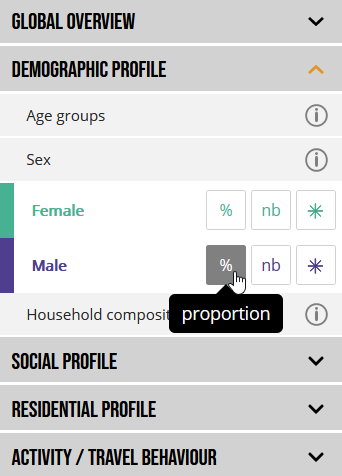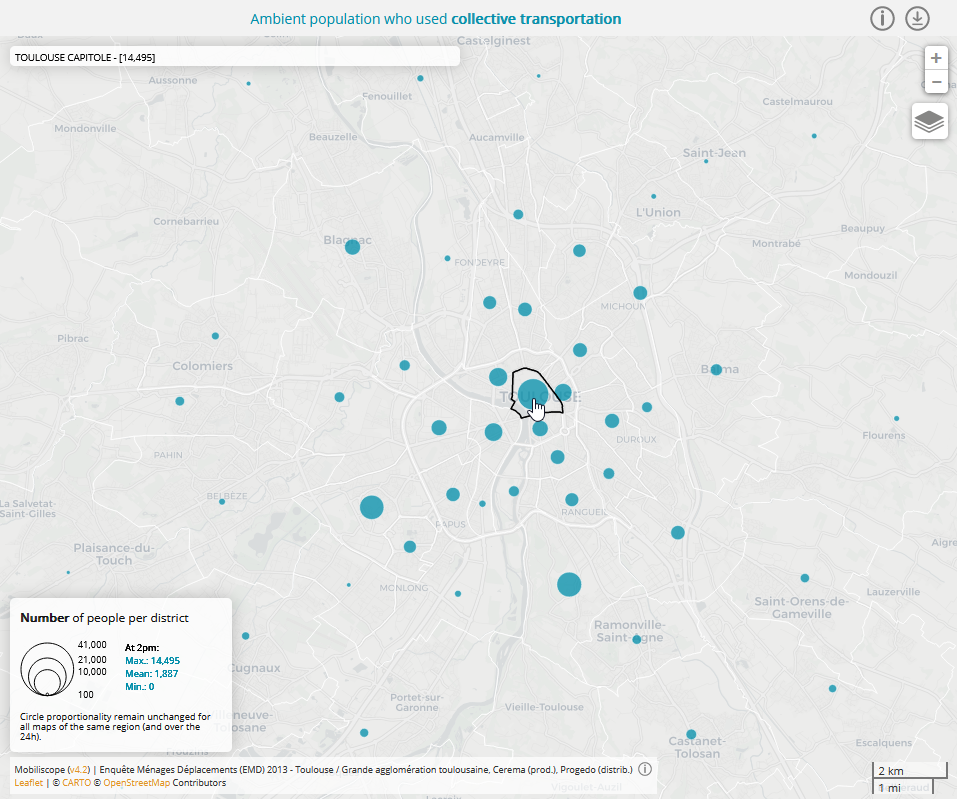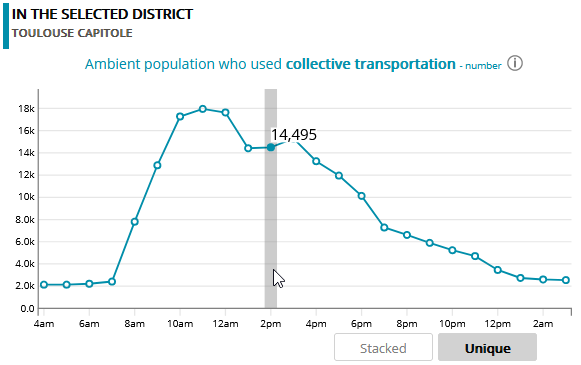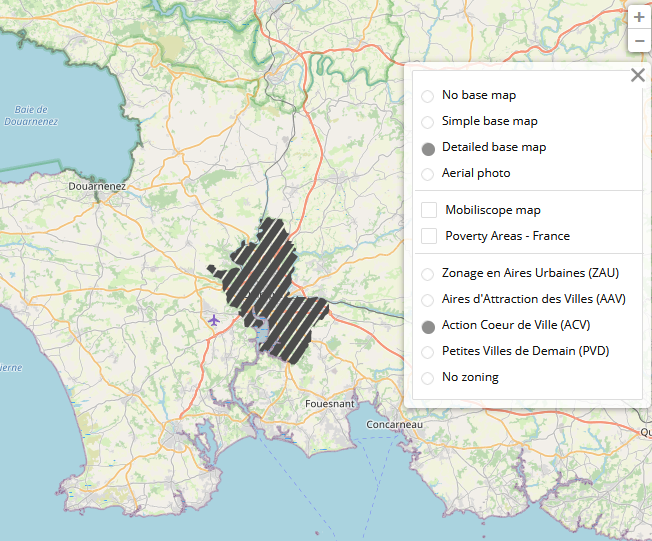Help to use the Mobiliscope
1) Preliminary notes
Initial data come from Origin-Destination surveys (from 2009 to 2019). Once transformed, these data have been used to estimate the ambient population in every district at exact hours (04.00, 05.00 etc.) during a typical weekday (Monday-Friday).
Number and proportion of ambient population aggregated by district and hour are estimation : they are subject to statistical margins of error.
58 city regions (spread over 5 countries) are included in the actual version of the Mobiliscope (v4.2).
To choose the city region you want to observe, please selection the city region in the drop-down menu or use the magnify tool
from a search by name.
2) Select a map
In the left-hand menu, you can choose indicator (classified into broad families such as demographic or social profile) and its map representation - eitheir as aof the total population, or number or flows.
To get informations about indicators, click button on the right side.

With flows maps you get number of non-resident people at district level. With links (displayed on mouseover), you can see their district of residence (not available on touch screens).

3) Change hours
At the top of the screen, click play button in the timeline to animate map and graphics according to the 24 hours of the day.

4) Explore a specific district
Select one district by clicking on the map.

Have a look at the chart entitled "In the selected district" where you can follow hourly variations of ambient population (for each group of the selected indicator) in the district under consideration. Colours have the same colour code than in the indicator menu. Here, last transportation mode used by present population in the selected district was coloured in blue for public transportation, in pink for private motor vehicle and in green for soft mobility.

By clicking on 'Unique' mode, you can limit representation of the hourly variations for only one subgroup :

5) Explore spatial segregation
The block of graphs entitled "In the whole region" displays two segregation indices computed from every district of the region for each hour of the day.
Duncan Index (also called Dissimilarity Index) measures the evenness with which a specific population subgroup is distributed across districts in a whole region. This index score can be interpreted as the percentage of people belonging to the subgroup under consideration that would have to move to achieve an even distribution in the whole region.

The example above displays, hour by hour, the Duncan Index (Paris region - 2010) for to ambient population residing in or outside 'Poverty Areas'. Duncan index range from 0 to 1. A Duncan Segregation Index value of 0 occurs when the share of ambient population residing in 'Poverty Areas' in every district is the same as the share of people residing in 'Poverty Areas' in the whole region. Conversely, a Duncan Segregation Index value of 1 occurs when each district gathers only one of the two population subgroups. In our example, Duncan value is found to be higher between 8pm and 7am, indicating a stronger segregation at night (further away from an even distribution): this corresponds to the hours when most of the individuals are at home or in their district of residence. The value of the index decreases during the day: because of their mobility, people residing in and outside of 'Poverty Areas' are more mixed (situation closer to even distribution).
By clicking on the "Moran" button, a second graph is displayed with the Moran index which measures the similarity in the profiles of the ambient population for neighbouring districts.

The Moran index values vary from -1 to +1: the closer its value is to 1, the more similar the spatially close districts are (with same distribution of the subgroup under consideration); the closer its value is to -1, the more dissimilar the spatially close districts are (with different distribution of the subgroup under consideration). When the Moran index value is 0, no similarity/dissimilarity pattern between neighbouring districts appears in the whole region. In our example, the Moran index values are positive and increase during the day: it means that spatial blocks of similar districts (according to the proportion of inhabitants of 'Poverty Areas') are formed during the day. This result does not contradict Duncan's index but complements it: people residing in 'Poverty Areas' visit during the day other districts than their residential district but tend to visit districts close to each other. And the same is true for people residing outside 'Poverty Areas'
It should be noted that in the case of an indicator subdivided into two groups (eg. male/female or people residing in/outside 'Poverty Areas'), Duncan and Moran values are the same for the two groups and therefore the curves are overlapping.
For more information on the two indices used (Duncan et Moran), click help button next to the index name.
6) Change map backgrounds
By clicking on the  button in the central map, several layers can be displayed to make it easier to find your way around the interactive map: a simple base map (default layer), a more detailed one and aerial photos.
button in the central map, several layers can be displayed to make it easier to find your way around the interactive map: a simple base map (default layer), a more detailed one and aerial photos.



In French cities, you can display official statistics zonings (Zonage en Aires Urbaines - ZAU de 2010 ; zonage en Aires d'Attraction des Villes AAV de 2020)


or some institutional zonings such as 'Poverty Areas' (QPV) or those related to 'Action Coeur de Ville' (ACV) or 'Petites Villes de Demain' (PVD) programs.



A tool can be used to list the French Mobiliscope areas according to their location in these three institutional zonings (ACV, PVD, QPV).
In Latin American cities, map backgrounds about municipalities and centre/periphery rings are available, as well as TransMilenio in Bogotá.

7) Download data
Data displayed in the Mobiliscope are under open license (ODbL). Mobiliscope data are reusable as they remain under open license and that the sources are mentioned.
By clicking on the button above the central map, you can download data aggregated data by district and by hour. By clicking on the
button in the bottom graph, you can also download data about hourly segregation values (Duncan's or Moran's index) computed for the whole region over the 24 hours period.
8) Partager une vue particulière
By clicking on the button , you can copy the URL of your map or share it directly by email or on social networks. The URL records your choice of indicator as well as the district and hour selected.
To go further
You can also visit the information pages of the website to learn more about our methodology and Geoviz process, as well as the codes and data available in open access.
Enjoy!
Team
Members
Julie Vallée is researcher in geography at the French National Center for Scientific Research (CNRS). She is a member of the LISST laboratory (Toulouse) and associated with the Géographie-cités laboratory (Paris). Julie is the scientific coordinator of the Mobiliscope. She is conducting research focusing on spatial mechanisms of social inequalities in urban areas. From people's daily mobility, she aims to explore neighbourhood effects (notably on health inequalities) and to analyse the 'daycourse' of place.
Aurélie Douet is an engineer in cartography and geomatics. She led the development of Mobiliscope for more than 4 years. In particular, she extended the platform to French cities other than the Paris region and integrated Latin American cities. More recently, she reorganised the data processing protocols and the software architecture. Since December 2023, Aurélie has been a research engineer at the Centre de Recherches Historiques (EHESS/CNRS) and continues to follow the progress of the project with interest.
Guillaume Le Roux is researcher at the French Institute for Demographic Studies (INED). His research focuses on the relationships between social mobility, spatial mobility and recomposition of territories under urban influence. Guillaume has critically contributed to the exploration of origin-destination survey database (EGT 2010, Paris region) in order to analyse social segregation around the clock.
Hadrien Commenges is an associate professor at the University Paris 1 Panthéon-Sorbonne. His research focuses on quantitative methods applied to urban geography, mainly in the field of urban mobility and transportation.
Previous members
Constance Lecomte developed in 2017 the first two versions of the Mobiliscope dedicated to Île-de-France. She then remained heavily involved in the Mobiliscope project while working at Observatoire des Territoires in the Agence nationale de la cohésion des territoires (ANCT).
Elisa Villard joined the team for several months in 2019. She was in charge of including Canadian cities in the Mobiliscope (following her five-month internship in Montreal).
Students
Several students have completed their master's theses with the Mobiliscope team.
- Robin Demé (Master 2 Démographie - Expertise en Sciences de la Population - Université Paris 1 Panthéon-Sorbonne). 2023.
- Baptiste Larrouy (Centrale Nantes School / Bachelor in Digital City - Geomatics and Urbanism). 2021.
- Élisa Villard (Centrale Nantes School / Bachelor in Digital City - Geomatics and Urbanism). 2019.
- Simon Oertlin (Université Paris 1 Panthéon-Sorbonne / Master in Geography). 2019.
- Maximilien Riot (Université de Nice / Master in Geomatics). 2019.
Others contributors
- Renaud Bessières (qodop) : web development
- Mathieu Leclaire (Géographie-cités/ISC-PIF) : IT reorganisation (hosting on HumaNum, data storage on MinIO, gitlab repositories, etc.)
- Barbara Christian and Julie Pelata (Cerema) : help with French origin-destination surveys (EMC²)
- Cédric Poirier : improving the interface
- Saber Marrouchi and Yonathan Parmentier (Géographie-cités) : IT support
- Florent Demoraes (Université de Rennes/ANR Modural) : critical feedback on the use of Latin American surveys and help with the Bogotá base map
- Marc Sainte-Croix and Blandine Maison (Agence d’urbanisme, région nîmoise et alésienne) : participation in the integration of Nîmes region
- Sébastien Haule (Géographie-cités) : communications support
- Robin Cura and Mattia Bunel (Géographie-cités) : geovisualisation advice
Join us!
Contact us (mobiliscope@cnrs.fr) if you want to join the team!
